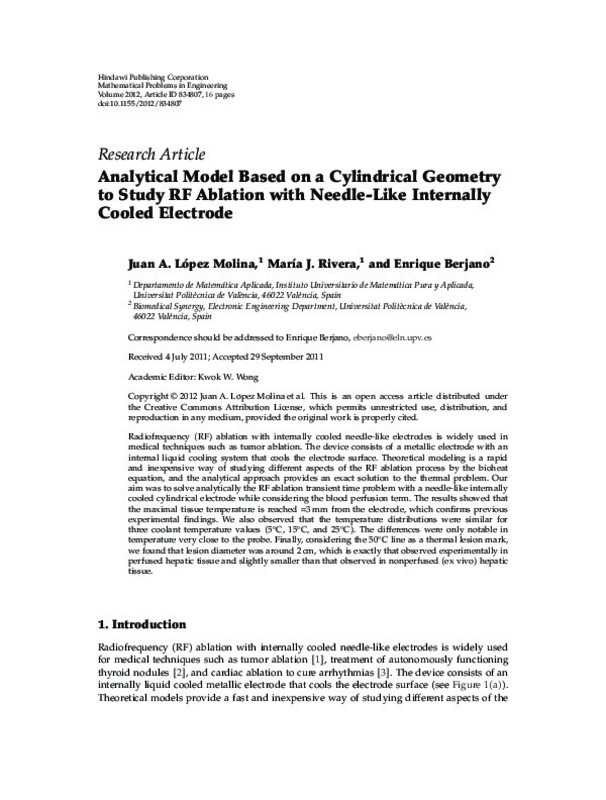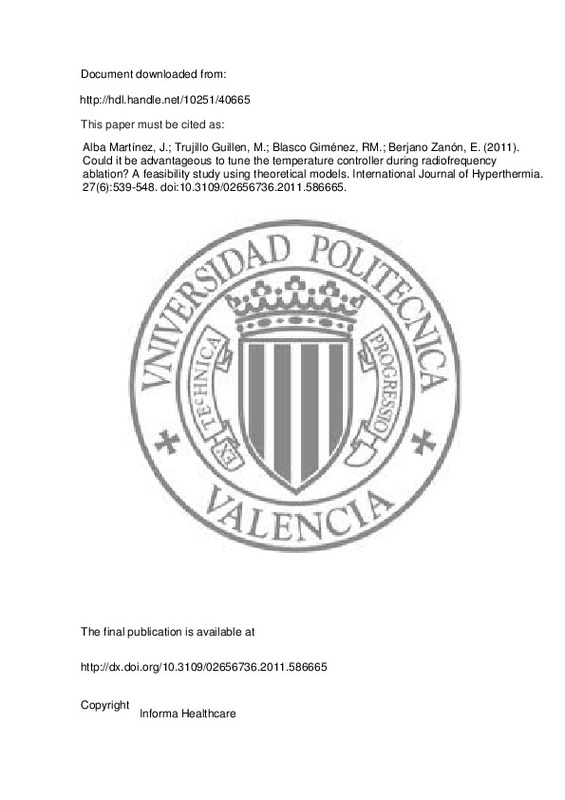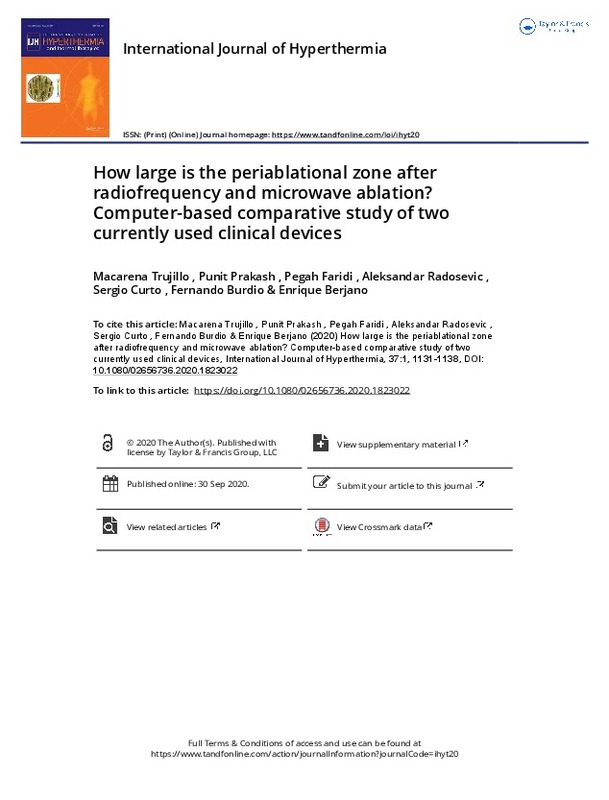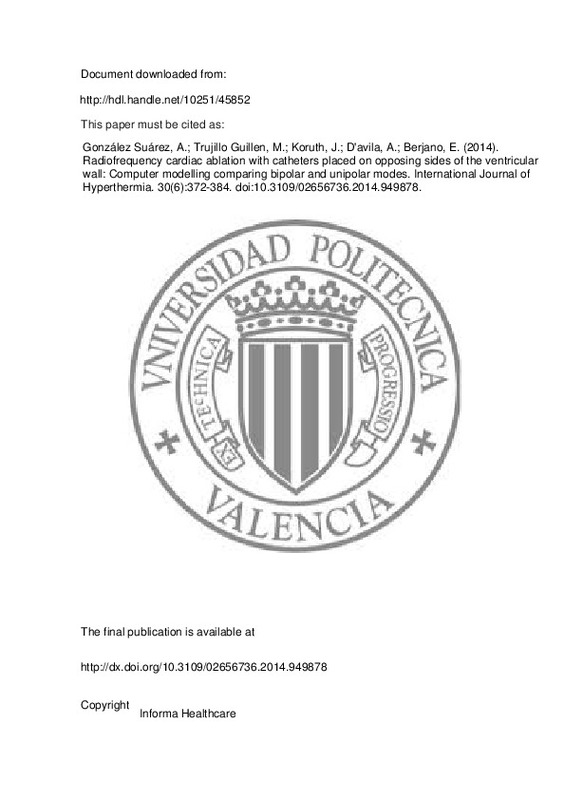López Molina, JA.; Rivera Ortun, MJ.; Berjano Zanón, E. (2012). Analytical Model Based on a Cylindrical Geometry to Study RF Ablation with Needle-Like Internally Cooled Electrode. Mathematical Problems in Engineering. 2012:1-16. https://doi.org/10.1155/2012/834807
Por favor, use este identificador para citar o enlazar este ítem: http://hdl.handle.net/10251/78698
|
Título:
|
Analytical Model Based on a Cylindrical Geometry to Study RF Ablation with Needle-Like Internally Cooled Electrode
|
|
Autor:
|
 López Molina, Juan Antonio
Rivera Ortun, María José
López Molina, Juan Antonio
Rivera Ortun, María José

 Berjano Zanón, Enrique
Berjano Zanón, Enrique
|
|
Entidad UPV:
|
Universitat Politècnica de València. Instituto Universitario de Matemática Pura y Aplicada - Institut Universitari de Matemàtica Pura i Aplicada
Universitat Politècnica de València. Escuela Técnica Superior de Ingeniería del Diseño - Escola Tècnica Superior d'Enginyeria del Disseny
Universitat Politècnica de València. Escuela Técnica Superior de Ingeniería Agronómica y del Medio Natural - Escola Tècnica Superior d'Enginyeria Agronòmica i del Medi Natural
|
|
Fecha difusión:
|
|
|
Resumen:
|
Radiofrequency (RF) ablation with internally cooled needle-like electrodes is widely used in medical techniques such as tumor ablation. The device consists of a metallic electrode with an internal liquid cooling system ...[+]
Radiofrequency (RF) ablation with internally cooled needle-like electrodes is widely used in medical techniques such as tumor ablation. The device consists of a metallic electrode with an internal liquid cooling system that cools the electrode surface. Theoretical modeling is a rapid and inexpensive way of studying different aspects of the RF ablation process by the bioheat equation, and the analytical approach provides an exact solution to the thermal problem. Our aim was to solve analytically the RF ablation transient time problem with a needle-like internally cooled cylindrical electrode while considering the blood perfusion term. The results showed that the maximal tissue temperature is reached 3mm from the electrode, which confirms previous experimental findings. We also observed that the temperature distributions were similar for three coolant temperature values (5 °C, 15 °C, and 25 °C). The differences were only notable in temperature very close to the probe. Finally, considering the 50 °C line as a thermal lesion mark, we found that lesion diameter was around 2cm, which is exactly that observed experimentally in perfused hepatic tissue and slightly smaller than that observed in nonperfused (ex vivo) hepatic tissue. Copyright © 2012 Juan A. Lpez Molina et al.
[-]
|
|
Palabras clave:
|
Ablation process
,
Analytical approach
,
Analytical model
,
Bio-heat equations
,
Blood perfusion
,
Coolant temperature
,
Cylindrical electrodes
,
Cylindrical geometry
,
Electrode surfaces
,
Ex-vivo
,
Exact solution
,
Hepatic tissue
,
Lesion diameter
,
Liquid cooling systems
,
Medical techniques
,
Metallic electrodes
,
Needle-like
,
Radiofrequency ablation
,
Theoretical modeling
,
Thermal lesion
,
Tissue temperatures
,
Transient time
,
Tumor ablation
,
Cooling systems
,
Cylinders (shapes)
,
Mathematical models
,
Needles
,
Tissue
,
Ablation
|
|
Derechos de uso:
|
Reserva de todos los derechos
|
|
Fuente:
|
Mathematical Problems in Engineering. (issn:
1024-123X
)
|
|
DOI:
|
10.1155/2012/834807
|
|
Editorial:
|
Hindawi Publishing Corporation
|
|
Versión del editor:
|
http://dx.doi.org/10.1155/2012/834807
|
|
Código del Proyecto:
|
info:eu-repo/grantAgreement/MICINN//TEC2008-01369/ES/MODELOS COMPUTACIONALES E INVESTIGACION EXPERIMENTAL EN EL ESTUDIO DE TECNICAS QUIRURGICAS DE CALENTAMIENTO DE TEJIDOS BIOLOGICOS MEDIANTE CORRIENTES DE RADIOFRECUENCIA./
|
|
Agradecimientos:
|
This work received financial support from the Spanish "Plan Nacional de I + D + i del Ministerio de Ciencia e Innovacion" Grant no. TEC2008-01369/TEC. The translation of this paper was funded by the Universitat Politecnica ...[+]
This work received financial support from the Spanish "Plan Nacional de I + D + i del Ministerio de Ciencia e Innovacion" Grant no. TEC2008-01369/TEC. The translation of this paper was funded by the Universitat Politecnica de Valencia, Spain.
[-]
|
|
Tipo:
|
Artículo
|












